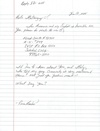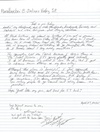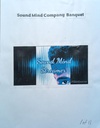uploaded May 30, 2020.
Original (PDF)

Other posts by this author
|
2025 jul 3

|
2025 jun 25

|
2025 may 6

|
2024 jun 12

|
2024 feb 20

|
2024 jan 5

|
More... |


Replies (7)
I hope this message finds you well! I am just coming accross this on fb:
Pride History
William Dorsey Swann was a gay liberation activist. Born into slavery in 1858, he was the first person in the United States to lead a queer resistance group and the first known person to self-identify as a "queen of drag". Imagine the queenery of this icon.
He was a slave in Hancock, Maryland and was freed by Union soldiers after the Emancipation Proclamation went into effect. During the 1880s and 1890s, he organized a series of balls in Washington, D.C. He called himself the "queen of drag". Most of the attendees his gatherings were men who were former slaves, and were gathering to dance in their satin and silk dresses.
William was arrested in police raids numerous times, including in the first documented case of arrests for female impersonation in the United States, on April 12, 1888. In 1896, he was falsely convicted and sentenced to 10 months in jail for "keeping a disorderly house" (running a brothel). After his sentencing, he requested a pardon from President Grover Cleveland. This request was denied, but he was the first American on record who pursued legal and political action to defend the LGBTQ community's right to gather.
He was known to have been close with Pierce Lafayette and Felix Hall, two men who had also both been slaves and who formed the first known male same-sex relationship between enslaved Americans.
When William stopped organizing and participating in drag events, his brother continued to make costumes for the drag community. Two of his brothers had also been active participants in his drag balls.
Imagine how intelligent and ambitious this man had to be to come up with drag balls in the 1800s! Imagine how many terrible concepts he had to unlearn by himself to be a confident gay black man who does drag in the 1800s! Imagine how courageous he had to be to fight for lgbt people as a former slave in America in the 1800s!
William Dorsey Swann is the original queen, the original drag mother, the original activist. Tell his story!
Big hug to you,
Love
Ju
The First Drag Queen Was a Former Slave
Who fought for queer freedom a century before Stonewall.
By Channing Gerard Joseph
His name was William Dorsey Swann, but to his friends he was known as “the Queen.” Both of those names had been forgotten for nearly a century before I rediscovered them while researching at Columbia University. Born in Maryland around 1858, Swann endured slavery, the Civil War, racism, police surveillance, torture behind bars, and many other injustices. But beginning in the 1880s, he not only became the first American activist to lead a queer resistance group; he also became, in the same decade, the first known person to dub himself a “queen of drag”—or, more familiarly, a drag queen.
In 1896, after being convicted and sentenced to 10 months in jail on the false charge of “keeping a disorderly house”—a euphemism for running a brothel—Swann demanded (and was denied) a pardon from President Grover Cleveland for holding a drag ball. This, too, was a historic act: It made Swann the earliest recorded American to take specific legal and political steps to defend the queer community’s right to gather without the threat of criminalization, suppression, or police violence.
When I tell people that I’m writing a book about the life of a former slave who reigned over a secret world of drag balls in Washington, DC, in the 1880s, the looks of shock, delight, and even confusion on their faces tell me all I need to know.
My research on Swann began 15 years ago, when I stumbled upon a Washington Post article from April 13, 1888. The headline leaped off the page: “Negro Dive Raided. Thirteen Black Men Dressed as Women Surprised at Supper and Arrested.” According to another news account, more than a dozen escaped as the officers barged in and Swann tried to stop them, boldly telling the police lieutenant in charge, “You is no gentleman.” In the ensuing brawl, the Queen’s “gorgeous dress of cream-colored satin” was torn to shreds. (The fight was also one of the first known instances of violent resistance in the name of LGBTQ rights.)
To 19th century observers, Swann’s dance party was a shocking and immoral fiasco perpetrated by a vanishingly tiny minority of “freaks.” The National Republican, another Washington daily, said of the men arrested in the raid, “It is safe to assert that the number living as do those who were taken into custody last night must be exceedingly small.” Yet, despite their minuscule numbers, they made quite an impression: Hundreds of onlookers followed the men to the station to steal a glimpse of silk and skin.
Drag balls had been going on in secret for years. Invitations to the dances, for instance, were often whispered to young men at the YMCA, and newspapers described the arrests of several black men wearing “bewitching” fascinators, silk sacques, or cashmere dresses while en route to balls. In 1882, Swann served a jail term for stealing plates, silverware, and other party supplies. But the 1887 raid was the first time the wider world learned of him and the motley group of messengers, butlers, coachmen, and cooks.
Swann’s drag balls came with grave risks to his guests’ reputations and livelihoods. A large but undetermined number managed to flee during the police raids, but the names of those arrested and jailed were printed in the papers, where the men became targets of public scorn. With the news coverage, the world took an interest—everyone from neighbors and police to local officials and even psychiatrists. Now that the group was publicly known, it would prove to be a fascinating new subject for researchers trying to grapple with the complexities of human sexuality and psychology. Lacking any of the terms we use today, like “cross-dresser,” “transgender,” and “gender-nonconforming,” Dr. Charles Hamilton Hughes described Swann’s group in an 1893 medical journal as an “organization of colored erotopaths” and a “lecherous gang of sexual perverts.” Another psychiatrist, Dr. Irving C. Rosse, described them as “a band of negro men with…androgynous characteristics.”
On the one hand, the publicity made it more difficult for Swann and his friends to stay hidden from those who sought to do them harm. On the other, now that their existence was widely known, more people might have been interested in joining his secretive all-male family.
Swann’s gatherings continued, featuring folk songs and dances, including the wildly popular cakewalk (so named because the best dancer was awarded a hoecake or other confection). Many guests dressed in women’s clothes, though some wore men’s suits. Harlem’s famous Hamilton Lodge masquerade balls, which began in 1883, were traditional masked dances and would not be “taken over by the gentry from fairyland,” as one Baltimore Afro-American reporter colorfully put it, until 1925 at the very earliest.
On April 16, 1862, Lincoln signed the compensated Emancipation Act, freeing all slaves in the District of Columbia. In the years after that, Washington came to be seen by newly liberated African Americans as a place of freedom and economic opportunity. Swann and many others in attendance at his balls were born in bondage, and many probably expected to live out their lives that way. Some of his friends vividly remembered growing up and coming of age in the antebellum years, when they were subject to their masters’ whips and whims. Finding love and joy in community with one another was essential to their survival.
Swann was the property of a white woman named Ann Murray and was living on her plantation in Hancock, Washington County, Maryland, when Union soldiers marched through in the winter of 1862. His intimate friend Pierce Lafayette—whose elegantly furnished two-story home was the site of the 1887 party—had been born enslaved in Georgia. Lafayette had been owned by Alexander H. Stephens, the vice president of the Confederate States of America. (It’s interesting to note that Lafayette’s prior relationship with Felix Hall, a male slave dubbed Lafayette’s “negro Mistress,” is the earliest documented same-sex romance between two enslaved men in the United States.) Also, two of Swann’s younger brothers attended his balls dressed in women’s clothing, demonstrating that the group truly was an extension of his family.
In 1900 and beyond, after William Swann’s retirement from the drag scene, his little brother Daniel J. Swann continued the family tradition in Washington. He provided costumes for the drag community there for roughly five decades, until his death in 1954—through the rise and fall of notable black DC drag queens like Alden Garrison and “Mother” Louis Diggs. (By the early 20th century, newspapers in the Baltimore and Washington area had documented the use of family terms to denote rank within groups of ball participants, with “mother” reserved for an older person serving as a mentor to younger ones. The term “queen,” though used loosely today, was until the 1960s often reserved for someone in a position of honor and leadership in the community.)
Though the Stonewall uprising of 1969 is often touted as the beginning of the fight for gay liberation, Swann’s courageous example forces us to rethink the history of the movement: when it began, where it came from, and who its leaders were. Coming of age at a time when an entirely new form of freedom and self-determination was developing for African Americans, Swann and his house of butlers, coachmen, and cooks—the first Americans to regularly hold cross-dressing balls and the first to fight for the right to do so—arguably laid the foundations of contemporary queer celebration and protest.
Channing Gerard Joseph, a journalist and historian, was recently awarded a 2019 Whiting Creative Nonfiction Grant.
found this article in the Nation, and next year there will be a publication of a book "The House of Swann", by the same journalist. Printing some fotos today!
Big hug, Ju